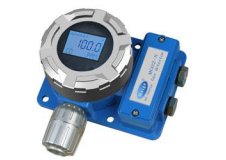Hazardous Gas Detection,standards and regulations
Combustion may take place when oxygen reacts rapidly with a flammable substance. It may cause an explosion, heat and fire. It's therefore important to detect flammable gas levels before it reaches its "lower explosive level" or LEL.
The IEC (International Electrotechnical Commission) is a worldwide organization for standardization. Under the recent changes applied by the IEC and European standards, LEL concentrations are defined measured using a 'stirred' concentration of gas as oppose to the 'still' gas method previous employed. The reason behind this is that some gases and vapours have proven to be more volatile when stirred.
Australia and Europe follow the new method, the US still uses the older "still" gas method for determine the LEL levels. The table below shows the LEL values of the IEC, European inclusive Australian standards as well as the US standards.
- Acetylene 2.3% (IEC) 2.4% (US)
- Ammonia 15.0% (IEC) 15.0% (US)
- Benzene 1.2% (IEC) 1.3% (US)
- Butane 1.4% (IEC) 1.8% (US)
- Ethanol 3.1% (IEC) 4.3% (US)
- Ethylene 2.3% (IEC) 2.7% (US)
- Hexane 1.0% (IEC) 1.1% (US)
- Hydrogen 4.0% (IEC) 4.0% (US)
- Methane 4.4% (IEC) 5.0% (US)
- Methanol 5.5% (IEC) 7.3% (US)
- Pentane 1.4% (IEC) 1.5% (US)
- Propane 1.7% (IEC) 2.1% (US)
Gas detection systems will detect and generate an alarm well before the concentrations reaches its LEL value (also called "100% LEL"). In Australia, the standards are set 5% LEL for first alarm level and 10% LEL for the second alarm level. Mining, oil and gas companies will generally apply their own alarm levels. International standards might vary from the Australian alarm levels as well.
Hazardous Installations
Most combustible gas detectors are installed in a hazardous area which could be classified as zone 2, 1 or 0. Its therefore important that the gas detection equipment complies with the applied zone. This includes detectors, cabling, audible visual alarms and other related materials and equipment installed in such areas. The international standards define three levels:
- Zone 2: An area in which an explosive atmosphere is not likely to occur in normal operation and if it does occur it will exists for a short period only. Type of protection would be Ex ic (Intrinsic Safety), Ex n (Non Sparking), Ex pz (Purge / pressurized).
- Zone 1: An area in which an explosive atmosphere is likely to occur in normal operation. Type of protection would be Ex d (Flameproof), Ex ib (Intrinsically Safe), Ex p (Pressurised Enclosure), Ex py (Purge / pressurized), Ex pl (Purged Enclosure), Ex px (Purge / pressurized), Ex mb (Encapsulation), Ex s (Special), Ex m (Encapsulation), Ex e (Increased Safety), Ex q (Powder / Sand Filled), Ex o (Oil Immersion).
- Zone 0: An area in which an explosive atmosphere is present continuously. Type of protection applied would be Ex ia (Intrinsically Safe), Ex ma (Encapsulation).
- Group I - Coal Mining (methane)
- Group II - Other Industries
- Group IIA (e.g. propane, butane)
- Group IIB (e.g. ethylene, butadiene)
- Group IIC (e.g. acetylene, hydrogen)
- AS/NZS 60079.14:2009 Explosive atmospheres - Electrical installations design, selection and erection
- AS/NZS 60079.17:2009 Explosive atmospheres - Electrical installations inspection and maintenance
- AS/NZS 4761.1:2008 Competencies for working with electrical equipment for hazardous areas (EEHA)
- AS/NZS 60079.29.2:2016 Explosive atmospheres - Gas detectors - Selection, installation, use and maintenance of detectors for flammable gases and oxygen
Areas subject to flammable dust hazards are classified as Zone 20, Zone 21 or Zone 22. In regards to certification: IECEx certificates are recognized in Australia, ensure your equipment complies with this standard.
Group Classification
Gases are grouped together based on the amount of energy required to ignite the explosive mixture of gases with air.



